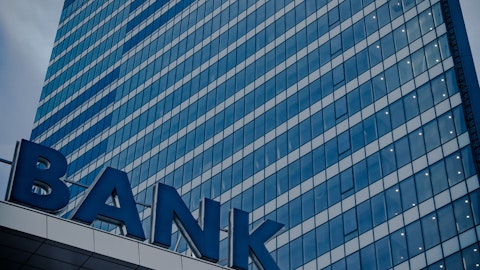I would assume you want to take that funding and maybe reduce some of the wholesale that you brought on, but that may be thinking about it incorrectly, just wanted to get some additional color?Paul Burdiss No, I think that’s approximately correct. You know, the way – we see brokered deposits as kind of another source of wholesale funds, really, even though they’re called deposits, they’re pretty rate sensitive, as you know. And so, that’s why we make an effort to break those out in our disclosures so that investors can see, sort of clearly core versus brokered deposits. We think that’s an important distinction. The maturity profile of those is a ladder profile that goes from, kind of 3 months to 18 months, you know, over the course and the rates paid on those are very, very competitive, as you would imagine.So, my expectation is, if we’re successful bringing in, you know, some of the deposits that have recently left the balance sheet due to rate for example, I believe that we could bring those in at a rate that’s lower than those brokered deposits.
The refinancing advantage, they’re a little hard to predict, it’s probably in the 100 basis point to 200 basis point range. That’s a little speculative, but that’s kind of how we think about it. It’s an alternative source of effectively wholesale borrowing.Brad Milsaps Great, thank you. And as my follow-up, you gave a lot of guidance around, you know, expenses. You also noted in the deck that you know, you’re looking for ways to maybe further reduce expenses, were those already be encompassed in your guide, or should I treat that comment as there could be more to come given the reduced revenue outlook?Paul Burdiss Those are incorporated into the outlook that we provided.Brad Milsaps Okay, great. Thank you very much.Paul Burdiss Thank you.Operator Thank you.
Our next question comes from Ken Usdin with Jefferies. Please proceed with your question.Ken Usdin Thanks a lot. I just wanted to come back onto the left side of the balance sheet. And are you talking a lot – we’re talking a lot about the rate. So, as you think about just like how the adjustments happen on the asset side, you know, just what is your general outlook for what the security portfolio and the [pace of runoff] [ph], I know, you gave us the AFS pulled apart. And then, you know, what – do you have any change changes here in terms of just how you look at loan growth in terms of that balancing act between, you know, loans and deposits from here? Thanks.Paul Burdiss Sure. On securities, as we’ve been reporting for some time, the duration of that portfolio has been pretty steady at around four years, and that’s over the course of the last year, despite a pretty massive change in interest rates.
That portfolio has been cash flowing at about, I’d say a little over $800 million a quarter. That’s been pretty consistent over the last year. And that’s the level of cash flow that I would expect to continue barring some unforeseen, kind of massive drop in longer-term rates. So that’ll, as you noted, we provided some level of disclosure around the amortization or the accretion of the accumulated other comprehensive loss that’s related to all those things. So, it remains a ready source of funds for us. I do not expect to be purchasing any securities. And I would expect the portfolio to be running off at, kind of that level, you know, certainly over the course of the next year.Harris Simmons And on the loan growth question that you asked, you know, the last, if you look at the last four quarters, four or five quarters we’ve had, they’ve been some of the strongest long growth quarters in our history.
And this quarter on a – as compared to the fourth quarter of 2022 is running at a rate that is more like what we saw throughout the latter part of, you know, 2015 through 2019. And so, it’s – you know, growing mid-single-digits is a very sustainable rate, we think.Ken Usdin Okay, just one follow-up, and Harris, I know where you stand on your view of TCE and unrealized losses, but just bigger, bigger picture with a lot of talk about, you know, what happens with re-regulation here? How do you think the, you know the crowd of banks were Zions hangs kind of that former [50 to 1 billion] [ph] crowd, you know, might be treated in terms of, you know, potential reregulation of your size type of bank?Harris Simmons Well, you know, the jury is still out.
My hope is that, there’ll be regulators and congress and others will come at this really thoughtfully because it has, beyond the banking system, it has a lot of implications for the housing markets, for example, I mean, a third of all the agency mortgage backed securities are held in the banking system. And if you create another surge held by the Fed, and you know, if those two, that two-thirds of those total holdings are trying to get rid of, I think it has a lot of implications for the 30-year mortgage [and thus for] [ph] housing.I truly believe that most banks that are more traditional, you know, half their deposits are more kind of insured. You know, they’re trying to balance, this balancing act between managing earnings at risk and creating some stability to the earnings stream, and the economic value of equity.
And to do that, I mean, that’s why we put a couple of slides in here showing, you know, if we weren’t using some of these tools, mortgage backed securities swaps, etcetera, you know, we’d be very asset sensitive, and you’d, you know, might be good for the economic value of equity, but not so much for earnings, stability.And so, and I’d also know, frankly, though, a lot of talk about stress tests. The fact of the matter is, that there’s a built, the stress tests have traditionally really focused on the more traditional causes of a trouble in the industry, which has been credit related. And there’s a built-in incentive to create duration in those stress tests so that you have an earnings stream during a period of economic weakness.And so all of those are the kinds of things I, you know, I would hope will be thought through and that there’s a balanced view of all of this, because I think the couple of banks that really have ignited this, you know, created this storm had very idiosyncratic, particularly Silicon Valley, obviously, but very idiosyncratic kinds of business models and deposit structures.
And we’ve got to be careful that we don’t throw out all the, you know, a lot of babies with the bathwater.So, that’s kind of how I feel, but I don’t know, how it’s going to get resolved. I expect that there’ll be a lot of discussion and probably some new regulation, I think we’re probably of a size that if they’re sensible about it, I think we’ll also be, kind of tapered in, I don’t think it will be sudden. There’s some very, very large banks, if you go about this with a [indiscernible], you’ve got some of the largest banks in the country that are going to have to raise tens upon tens upon tens of billions of dollars of capital. I’m not sure the market could even absorb it very well. So, just some random thoughts about it.Ken Usdin Appreciate your thoughts, Harris.
Thank you.Operator Thank you. Our next question comes from Ebrahim Poonawala with Bank of America. Please proceed with your question.Ebrahim Poonawala Good afternoon. A couple of follow up questions. One. I think you provided the spot cost of deposits at 163 for interest bearing deposits. And apologies if I missed it, but can you remind us where you expect terminal deposit bearers? If we think that the Fed has maybe one more rate hike to go? Where do you think interest bearing deposits, or total deposit cost level out for the bank?Harris Simmons Right, so I won’t give you the precise cost, but I will say, as I said previously, we expect to kind of over the cycle deposit beta, and we’re going to see some catch up on this this year to be up just under 50%, about 45%.
Sorry, for interest bearing specifically, which I think was your question.Ebrahim Poonawala Got it. And do you expect to get there by the end of the year?Harris Simmons I suspect we would. Yes.Ebrahim Poonawala I guess this is a separate question. So, you provided detail on the CRE book, maybe a question for Michael. Just in terms of from your lens, when you look at the CRE market, a lot of concern, do you think that the market is right in focusing on Office CRE as probably the most stressful area or if rates remain higher for longer do you worry about this spreading beyond just the office sub sector?Michael Morris Well, I do think office is going to be really challenged for quite a few years. And it has a lot to do with remote work optionality and sort of the new model that’s developing and how do you right size the architecture and the design and the current four plates.
And those tenants who are downsizing? So, I think office will continue to be, you know, one of the tougher segments in the industry, not just in our market. And I don’t think it is more of a contagion kind of issue. I don’t see the other asset classes being stressed, because it really has to do with where we work.Industrial has done well, continues to do well. Multifamily may have been over supplied going into the pandemic, but there isn’t a lot of activity over the last three years in multifamily. And if there is, it’s starting back up, so I’m not too worried about multifamily. I think supply and demand are pretty much in equilibrium. You know, hospitality will continue to be, I think underwritten pretty conservative underwriting guidelines, potentially throughout the industry.You know, homebuilders are coming back.
We were fairly concerned about homebuilders last year and the year before even though they were setting records for sales. We saw sales really dry up last year, but they’re coming back and we feel good about our homebuilder portfolio and potentially the industry as rates either flatten and plateau or even move down a little bit by the end of the years, [some of the thinking] [ph].Ebrahim Poonawala Thank you.Operator Thank you. Our next question comes from Brandon King with Truist Securities. Please proceed with your question.Brandon King Hey, good afternoon.Harris Simmons Hey, Brandon.Brandon King So, I appreciate all the color and details as far as credit quality and all the trends. I wanted to get a sense of what you’re thinking, as far as the cadence of net charge-offs as we progress through the year and as losses normalize from very low levels?Harris Simmons Well, I think it’s going to be – currently, we, you know, I don’t think there’s anything that’s looming large on the radar, in terms of problems that we can see coming at us.
What we see coming at us though is, you know, the Feds have been working at this in terms of trying to slow things to slow demand. I think what we’ve seen in the regional bank, and community bank space, no, probably going to have everybody more focused than they had been on liquidity and capital.And that will, you know, I think there’s an expectation that that’s going to create tighter credit conditions. And so, you know, I think we, you know, we expect it will probably there’s a higher likelihood of recession, that’s why we built reserves during the quarter. And, you know, you hope that you’re going to get through it pretty good shape. I expect we will in a relative sense, but, you know, it’s, the reserves are there for events that we think are very possible out through the life of these loans.It’s our best estimate, I guess, kind of, almost by definition, that’s how we arrive at the number.




